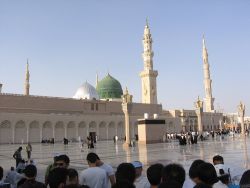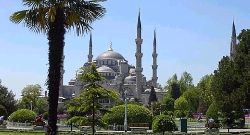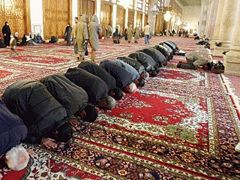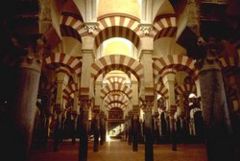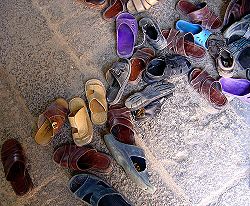Mosque
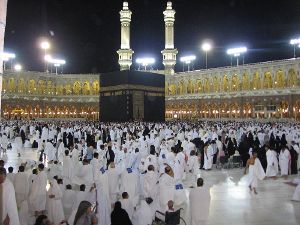
A mosque is a place of worship for Muslims (followers of Islam). Muslims often refer to the mosque by its Arabic name, masjid (Arabic: ŔÖō≥ō¨ōĮ). Mosques originated on the Arabian Peninsula, but now exist on all the world's inhabited continents. The primary purposes of a mosque are to serve as a place where Muslims can come together for prayer, celebrate special events, learn about Islam, and meet fellow believers. Mosques are also known for their Islamic architecture and may include elaborate domes, minarets, and prayer halls.
Etymology
The Arabic word masjid means place of worship and derives from the verb sajada (root "s-j-d," meaning "to bow" or "to kneel") in reference to the prostrations performed during Islamic prayers. Either the word masjid itself (or at least the verb from which it is derived) was borrowed from Aramaic. The word "m-s-g-d" is attested in Aramaic as early as the fifth century B.C.E., and the same word is later found in Nabataean inscriptions with the meaning "place of worship"; apparently, this Aramaic word originally meant "stele" or "sacred pillar."[1]
The modern-day English word "mosque," just like its equivalents in many other European languages, derives from the word masjid via Spanish mezquita.[1] The pre-cursors of the word "mosque" appeared during the fifteenth, sixteenth, and seventeenth centuries and "Moseak," "muskey," "moschy," and "mos'keh" were just some of the variations that came into use until it was decided that "mosquee," imitating Middle French, Italian, and Old Spanish, would become the standard. In the early eighteenth century, the modern spelling became the most popular in the English language.
History
The first three mosques were very simple open spaces on the Arabian Peninsula. Over the next one thousand years, mosques evolved significantly acquiring their now-distinctive features (such as grand entryways and tall towers, or minarets) and adapting to cultures around the world.
According to Islamic beliefs, the first mosque in the world was the Kaaba (or Kaabah), which was built by Abraham upon an order from Allah. The word "masjid" is found throughout the Qur'an, most frequently with the reference to the sanctuary of Kaaba in the city of Mecca. The Qur'an applies the term "masjid" to places of worship of different religions, including Judaism and Christianity; in the same general meaning of a place of worship, the word is used in the hadith, collections of Muslim traditions about the deeds and saying of their prophet Muhammad and his companions.[1] When Muhammad lived in Mecca, he viewed Kaaba as his first and principal mosque and performed prayers there together with his followers. Even during times when the pagan Arabs performed their rituals inside the Kaaba, Muhammad always held the Kaaba in very high esteem. The Meccan tribe of Quraish, which was responsible for guarding Kaaba, attempted to exclude Muhammad's followers from the sanctuary, which became a subject of Muslim complaints recorded in the Qur'an.[1] When Muhammad conquered Mecca in 630, he converted Kaaba to a mosque, which has since become known as the Masjid al-Haram, or ‚ÄúSacred Mosque.‚ÄĚ The Masjid al-Haram was significantly expanded and improved in the early centuries of Islam in order to accommodate the increasing number of Muslims who either lived in the area or made the annual Hajj, or pilgrimage, to Mecca, before it acquired its present shape in 1577 in the reign of the Ottoman sultan Selim II.[2]
The first thing Muhammad did upon arriving with his followers near Medina (then named Yathrib) after the emigration from Mecca in 622, was build the Quba Mosque in a village outside Medina.[3]
Just days after beginning work on the Quba' Mosque, Muhammad went on to establish another mosque in Medina, known today as the Masjid al-Nabawi, or ‚Äúthe Prophet's Mosque.‚ÄĚ The location of the mosque was declared as such after it hosted Muhammad's first Friday prayer. Following its establishment, the Masjid al-Nabawi continued to introduce some of the practices now considered common in today's mosques. For example, the adhan, or call to prayer, was developed in the form still used in mosques today. The Masjid al-Nabawi was built with a large courtyard, a motif common among mosques built since then. Muhammad would stand up at one end of the arcade to preach. Later on, he would develop a three-step pulpit as a platform from which he would give sermons. The pulpit, now known as a minbar, is still a common feature of mosques.
Muhammad lived beside the mosque in Medina, which doubled as both a religious and political center for the early Muslim community. Negotiations were conducted, military actions planned, prisoners of war held, disputes settled, religious information disseminated, gifts received and distributed among his companions. His followers treated the wounded there and some people even lived in the mosque permanently in tents and huts. [1]
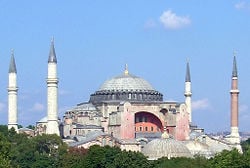
Conversion of non-Muslim houses of worship into mosques began during the life of Muhammad, who turned the pagan sanctuary of Kaaba into a mosque, and continued during subsequent Islamic conquests and under the Muslim rule. As a result, numerous churches, synagogues, Zoroastrian and Hindu temples became Muslim places of worship. According to Islamic law, non-Muslims should not continue to use their places of worship for their intended purposes if they are conquered by Muslims and if there exists no treaty of surrender that explicitly mentions the right of non-Muslims to continue to use their places of worship.[4] According to early Muslim historians, towns that surrendered without resistance and made treaties with the Muslims received permission to retain their churches and synagogues, while in towns taken by conquest, Jewish and Christian places of worship were seized by the Muslims.[1][5]
Mosques were built outside the Arabian Peninsula as Muslims moved to other parts of the world. Egypt was occupied by Muslim Arabs as early as 640, and since then so many mosques have appeared throughout the country that its capital city, Cairo, has acquired the nickname of ‚Äúcity of a thousand minarets.‚ÄĚ[6] Egyptian mosques vary in amenities, as some have Islamic schools (madrassas) while others have hospitals or tombs.[7]
Mosques in Sicily and Spain do not reflect the architecture of Visigoth predecessors, but instead reflect the architecture introduced by the Muslim Moors.[8]

The first Chinese mosque was established in the eighth century in Xi'an. The Great Mosque of Xi'an, whose current building dates from the eighteenth century, does not replicate many of the features often associated with traditional mosques. Instead, it follows traditional Chinese architecture. Mosques in western China incorporate more of the elements seen in mosques in other parts of the world. Western Chinese mosques were more likely to incorporate minarets and domes, while eastern Chinese mosques were more likely to look like pagodas.
Mosques first arrived in the Ottoman Empire during the eleventh century, when many of the Turks in the region began to convert to Islam. Several of the first mosques in the Ottoman Empire, such as the Hagia Sophia in present-day Istanbul, were originally churches or cathedrals in the Byzantine Empire. The Ottomans created their own design of mosques, which included large central domes, multiple minarets, and open façades. The Ottoman style of mosques usually included elaborate columns, aisles, and high ceilings in the interior, while incorporating traditional elements, such as the mihrab. Today, Turkey is still home to many mosques that display this Ottoman style of architecture.
Mosques diffused into India during the reign of the Mughal Empire in the sixteenth and seventeenth centuries. The Mughals brought their own form of architecture that included pointed, onion-shaped domes, as seen in Delhi's Jama Masjid.
Mosques gradually diffused to different parts of Europe. Major European cities, such as Rome, London, and Munich, are home to mosques that feature traditional domes and minarets. These large mosques in urban centers serve as community and social centers for Muslims. Mosques first appeared in the United States in the early twentieth century, the first of which was built in the late 1920s in Cedar Rapids, Iowa. However, as more immigrants continued to arrive in the country, especially from South Asia, the number of American mosques grew.
Religious functions
Prayers
All adult Muslims are required to offer prayer, or salat, at least five times each day. Although some smaller mosques with smaller congregations will offer only a few prayers, most mosques offer all five required prayers daily: before sunrise (fajr), at midday (dhuhr), in the afternoon (asr), after sunset (maghrib), and in the evening (isha'a). Muslims are not required to offer prayer inside a mosque, but according to hadith, offering prayer in congregation at a mosque is considered more virtuous than offering prayer alone.
In addition to holding the five obligatory daily prayers, mosques hold jumuah prayers, or Friday prayers, which replace the midday prayer as the second required prayer on Fridays. While the ordinary daily prayers can be performed at any location, it is required that all adult men attend Friday prayers at the mosque.[9]
A funeral prayer, or salat ul-janazah, is held for a deceased Muslim at the mosque, with all congregants present, including the imam, participating. Unlike with the daily prayers, the funeral prayers are normally held outdoors in a courtyard or square close to the mosque.[10] During solar eclipses, mosques will host another special prayer called salat ul-kusuf.[11]
There are two large holidays, or eids, in the Islamic calendar: Eid ul-Fitr and Eid ul-Adha. On both of these days, there are special prayers held at mosques in the morning. The eid prayers are supposed to be offered in large groups, and so larger mosques will normally host eid prayers for their congregants as well as the congregants of smaller local mosques. Some mosques will even rent convention centers or other large public buildings to hold the large number of Muslims who attend the eid prayers. Mosques, especially those in countries where Muslims are the majority, will also host eid prayers outside in courtyards or town squares.
Ramadan events
Islam's holiest month, Ramadan, is observed through many events. As Muslims must fast during the day during Ramadan, mosques will host iftar (breakfast) dinners after sunset and the fourth required prayer of the day, maghrib. Food is provided, at least in part, by members of the community, thereby creating nightly potluck dinners. Because of the community contribution necessary to serve iftar dinners, mosques with smaller congregations may not be able to host the iftar dinners daily. Some mosques will also hold suhoor meals before dawn to congregants attending the first required prayer of the day, fajr. As with iftar dinners, congregants usually provide the food for suhoor, although able mosques may provide food instead. Mosques will often invite poorer members of the Muslim community to share in beginning and breaking the fasts as providing charity during Ramadan in Islam is especially honorable.
Following the fifth and final required prayer of the day, isha, special, optional tarawih prayers are offered in larger Sunni mosques. Shi'a mosques, however, do not observe tarawih prayers. During each night of prayers, which can last for up to two hours each night, a member of the community who has memorized the entire Qur'an will recite a segment of the book.[9] During the last ten days of Ramadan, larger mosques will host all-night programs to observe Laylat al-Qadr, the night Muslims believe the Islamic prophet Muhammad first began to receive the Qur'an.[9] On that night, between sunset and sunrise, mosques will employ speakers to educate congregants in attendance about Islam. Mosques or the community usually provide meals periodically throughout the night.
During the last ten days of Ramadan, larger mosques within the Muslim community will host i'tikaf, a practice in which at least one Muslim man from the community must participate. Muslims performing i'tikaf are required to stay within the mosque for ten consecutive days, often in worship or learning about Islam. As a result, the rest of the Muslim community is responsible for providing the participants with food, drinks, and whatever else they need during their stay.[9]
Charity
The third of the Five Pillars of Islam states that Muslims are required to give approximately one-fortieth of their wealth to charity as zakat. Since mosques form the center of Muslim communities, they are where Muslims go to both give zakat and, if necessary, collect zakat. Prior to the holiday of Eid ul-Fitr, mosques also collect a special zakat that is supposed to assist in helping poor Muslims attend the prayers and celebrations associated with the holiday.
Social functions
Center of Muslim community
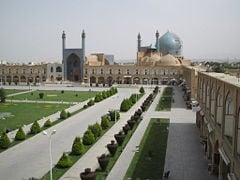
Many Muslim rulers after the death of the Islamic prophet Muhammad, emulating him, established their domains by first building a mosque. In the same way Mecca and Medina are built around the Masjid al-Haram and the Masjid al-Nabawi, Karbala, in present-day Iraq, was built around the Shi'ite Imam Hussain Shrine. Isfahan, Iran is especially notable for its use of mosques to form the center of the city. In the eighth century, a mosque was established within the city. At the dawn of the seventeenth century, Shah Abbas I of the Safavid Dynasty led an effort to establish Isfahan as one of the largest and most beautiful cities in the world. As part of his plan, he ordered the building of Shah Mosque and Sheikh Lotf Allah Mosque, which border Isfahan's Naghsh-i Jahan Square, becomming one of the largest city squares in the world.[12]
Mosques built more recently, especially in countries where Muslims are not the majority, tend to be away from the center of major cities. Nevertheless, even a mosque in a less densely populated area often influences Muslims to relocate their homes and businesses so they are close to the mosque. Thus, mosques form the focal points of Muslim communities, even if they do not form the center of the entire community as a whole. In the United States, the growth in the number of mosques and congregants in suburbs is much greater than that in dense urban areas.[13]
Education
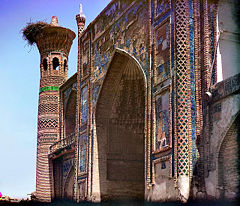
Another primary function of a mosque is to house educational facilities. Some mosques, especially those in countries where state-funded Islamic schools are not present, will have full-time schools that teach both Islamic and general knowledge. Qur'an reading and Arabic are commonly taught at mosques that are located in countries where Arabic is not widely spoken. Classes for new Muslims about the basics of Islam are also common, especially in Europe and the United States, where it is the fastest-growing religion.[14] Madrassas are also available for Muslims to study 'alim to become Islamic scholars or imams. However, madrassas are normally separate from neighborhood mosques.
Contemporary political roles
The late twentieth century saw an increase in the number of mosques used for political purposes. As they are considered important to the Muslim community, mosques are often at the heart of social conflicts. While a small number of mosques have become the platforms of some extremist speakers to advocate terrorism, the vast majority of Muslims denounces terrorism and promotes peace. Nevertheless, the growth of mosques in the west has alarmed some European residents who feel intimidated by the presence of Muslims in predominantly Christian neighborhoods.[15]
Following the attacks of September 11, 2001, several American mosques were targeted by hate crimes ranging from simple vandalism to arson.
Architecture
Styles
Arab-plan or hypostyle mosques are the earliest type of mosques, pioneered under the Umayyad Dynasty. These mosques are a square or rectangular in plan with an enclosed courtyard and a covered prayer hall. Historically, in the warm Mediterranean and Middle Eastern climates, the courtyard served to accommodate the large number of worshippers during Friday prayers. Most early hypostyle mosques have flat roofs on top of prayer halls, which resulted in the need to use numerous columns and supports.[1] One of the most notable hypostyle mosques is the Mezquita in Córdoba, Spain, as the building is supported by over 850 columns.[16] Frequently, hypostyle mosques have outer arcades so that visitors could enjoy some shade. Arab-plan mosques were constructed mostly under the Umayyad and Abbasid dynasties; subsequently, however, the simplicity of the Arab plan limited the opportunities for further development, and as a result, this architectural style gradually fell out of popularity.[1]
The Ottomans introduced central dome mosques in the fifteenth century and have a large dome centered over the prayer hall. In addition to having one large dome at the center, there are often times smaller domes that exist off-center over the prayer hall or throughout the rest of the mosque, where prayer is not performed.[16] This style was heavily influenced by the Byzantine religious architecture with its use of large central domes.[1]
Iwan mosques are most notable for their domed chambers and iwans, which are vaulted spaces open out on one end. In iwan mosques, one or more iwans face a central courtyard that serves as the prayer hall. The style represents a borrowing from pre-Islamic Iranian architecture and has been used almost exclusively for mosques in Iran. Many iwan mosques are converted Zoroastrian fire temples where the courtyard was used to house the sacred fire.[1] The Shah Mosque in Isfahan, Iran is a classic example of an iwan mosque.
Minarets
A common feature in mosques is the minaret, the tall, slender tower that usually is situated at one of the corners of the mosque structure. The top of the minaret is always the highest point in mosques that have one, and often the highest point in the immediate area. The tallest minaret in the world is located at the Hassan II Mosque in Casablanca, Morocco.[17]
The first mosque had no minarets, and nowadays the most conservative Islamic movements, like Wahhabis, avoid building minarets, seeing them as ostentatious and unnecessary. The first minaret was constructed in 665 in Basra during the reign of the Umayyad caliph Muawiyah I. Muawiyah encouraged the construction of minarets, as they were supposed to bring mosques on par with Christian churches with their bell towers. Consequently, mosque architects borrowed the shape of the bell tower for their minarets, which were used for essentially the same purpose‚ÄĒcalling the faithful to prayer.[18]
Before the five required daily prayers, a muezzin calls the worshipers to prayer from the minaret. In many countries where Muslims are not the majority, mosques are prohibited from loudly broadcasting the call to prayer (adhan), although it is supposed to be said loudly to the surrounding community. The adhan is not required before every prayer. However, nearly every mosque assigns a muezzin for each prayer to say the adhan as it is a recommended practice or sunnah of the Islamic prophet Muhammad. At mosques that do not have minarets, the adhan is called instead from inside the mosque or somewhere else on the ground.[9]
Domes
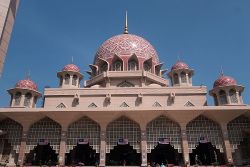
According to Pope (1965), two important contributions to architecture by the pre-Islamic Parthian and Sassanian Persians were domes and arches.[19] Domes have long been a hallmark of mosques and Islamic architecture in general since the seventh century. Moreover, it was in this century that Islam was introduced to Persia. The domes, which often are placed directly above the main prayer hall, may signify the vaults of heaven and the sky.[20] As time progressed, the sizes of mosque domes grew, from occupying only a small part of the roof near the mihrab to encompassing all of the roof above the prayer hall. Although domes normally took on the shape of a hemisphere, the Mughals in India popularized onion-shaped domes in South Asia and Persia.[21] Some mosques will have multiple, often smaller, domes in addition to the main large dome that resides at the center.
Prayer hall
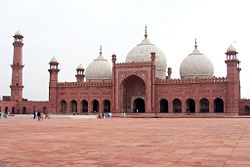
The prayer hall, also known as the musalla, has no furniture; chairs and pews are absent from the prayer hall so as to allow as many worshipers as possible to line the room. Prayer halls contain no images of people, animals, and spiritual figures as Muslims in prayer are supposed to only be focusing on Allah. Instead, mosques will have Arabic verses from the Qur'an on their walls to assist worshippers in focusing on the beauty of Islam and its holiest book, the Qur'an, as well as for decoration.[9]
Usually opposite the entrance to the prayer hall is the qibla wall, which is the visually emphasized area inside the prayer hall. The qibla wall should, in a properly oriented mosque, be set perpendicular to a line leading to Mecca, the location of the Ka'bah.[22] Congregants pray in rows parallel to the qibla wall and thus arrange themselves so they face Mecca. In the qibla wall, usually at its center, is the mihrab, a niche or depression indicating the qibla wall. Usually the mihrab is not occupied by furniture either. Sometimes, especially during Friday prayers, a raised minbar (pulpit) is located to the side of the mihrab for a khatib or some other speaker to offer a sermon (khutbah). The mihrab serves as the location where the imam leads the five daily prayers on a regular basis.[23]
Ablution facilities
As ritual purification precedes all prayers, mosques often have ablution fountains or other facilities for washing in their entryways or courtyards. However, worshippers at much smaller mosques often have to use restrooms to perform their ablutions. In traditional mosques, this function is often elaborated into a freestanding building in the center of a courtyard.[16] This desire for cleanliness extends to the prayer halls where shoes are disallowed to be worn anywhere other than the cloakroom. Thus, foyers with shelves to put shoes and racks to hold coats are commonplace among mosques.
Contemporary features
Modern mosques have a variety of amenities available to their congregants. As mosques are supposed to appeal to the community, they may also have additional facilities, from health clinics to libraries to gymnasiums, to serve the community.
Rules and etiquette
Mosques, in accordance with Islamic practices, institute a number of rules intended to keep Muslims focused on worshipping Allah. While there are several rules, such as those regarding allowing shoes in the prayer hall, that are universal, there are many other rules that are dealt with and enforced in a variety of ways from mosque to mosque.
Prayer leader
Appointment of a prayer leader is considered desirable, but not always obligatory.[24] The permanent prayer leader (imam) must be a free honest man, who has learned the Qur'an by heart and is authoritative in religious matters.[24] In mosques constructed and maintained by the government, the prayer leader is appointed by the ruler;[24] in private mosques, however, the appointment is done by the members of the congregation through majority voting. According to the Hanafi school of Islamic jurisprudence, the man who built the mosque has a stronger claim to the title of imam, but this view is not shared by the other schools.[24]
Leadership at prayer falls into three categories, depending on the type of prayer: five daily prayers, Friday prayer, or optional prayers.[24] According to the Hanafi and Maliki school of Islamic jurisprudence, appointment of a prayer leader for Friday service is mandatory because otherwise the prayer is invalid. The Shafi'i and Hanbali schools, however, argue that the appointment is not necessary and the prayer is valid as long as it is performed in a congregation. A slave may lead a Friday prayer, but Muslim authorities disagree over whether the job can be done by a minor.[24] An imam appointed to lead Friday prayers may not also lead at the five daily prayers; however, Muslim scholars disagree as to whether the leader appointed for five daily services may lead the Friday service as well.[24]
All Muslim authorities hold the consensus opinion that women may not lead prayer.[24] Recently, the rule was relaxed in some places in China, where women have been allowed to lead prayer in front of all-female congregations.[25] There have been a few women, most notably Amina Wadud, who have defied the ruling and have opted to lead mixed-gender prayers and Friday prayers.[26]
Cleanliness
All mosques have rules regarding cleanliness, as it is an essential part of the worshipper's experience. Muslims before prayer are required to cleanse themselves in an ablution process known as wudu. However, even to those who enter the prayer hall of a mosque without the intention of praying, there are still rules that apply. Shoes must not be worn inside the carpeted prayer hall. Some mosques will also extend that rule to include other parts of the facility even if those other locations are not devoted to prayer. Congregants and visitors to mosques are supposed to be clean themselves.
Dress
Islam requires that its adherents wear clothes that portray modesty. As a result, although many mosques will not enforce these rules, both men and women when attending a mosque are expected to adhere to these guidelines. Men are supposed to come to the mosque wearing loose and clean clothes that do not reveal the shape of the body. Likewise, it is recommended that Muslim women wear loose clothing, shirts, and pants that cover to the wrists and ankles. Many mosques will require that non-Muslim female visitors also wear a scarf to cover the head in the style of the Islamic hijab. Middle Eastern clothing often associated with Islam is not necessary, although many Muslims, regardless of their ethnic background, will wear them to special occasions and prayers at mosques.[9]
Concentration
As mosques are places of worship, those within the mosque are required to remain respectful to those in prayer. Loud talking within the mosque, as well as discussion of topics deemed disrespectful, is forbidden in areas where people are praying. In addition, it is disrespectful to walk in front of or otherwise disturb Muslims in prayer. The walls within the mosque have few items, except for possibly Arabic calligraphy, so Muslims in prayer are not distracted. Muslims are also discouraged from wearing clothing with distracting images and symbols so as not to divert the attention of those standing behind them during prayer.
Gender separation
Islamic law requires men and women to be separated in the prayer hall. Muhammad preferred women to pray at home rather than at a mosque, and according to the hadith, Muhammad said: "The best mosques for women are the inner parts of their houses." The second caliph Umar went so far as to prohibit women from attending mosques and required them to pray at home.[27] Sometimes a special part of the mosque was railed off for women; for example, the governor of Mecca in 870 had ropes tied between the columns to make a separate place for women.[1] Many mosques today will put the women behind a barrier or partition or in another room. Mosques in South and Southeast Asia put men and women in separate rooms, as the divisions were built into them centuries ago. In nearly two-thirds of American mosques, women pray behind partitions or in separate areas, not in the main prayer hall; some mosques do not admit women at all. Almost a quarter of the mosques do not offer programs for women, and one-third does not allow women on governing boards. The large crowds present at the Masjid al-Haram in Mecca, especially during the annual pilgrimage, often result in unintended mixing between genders. Some Islamic jurists would prefer to exclude women from prayer halls altogether.[1]
Women are subjected to other restrictions in mosques. Some hadith indicate that women must not be perfumed while others say that women must leave the mosque before the men.[1]
Non-Muslims in mosques
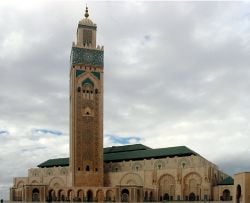
Under most interpretations of Islamic law, non-Muslims may be allowed into mosques, as long as they do not sleep or eat there; the dissenting opinion is presented by the followers of the Maliki school of Islamic jurisprudence, who argue that non-Muslims may not be allowed into mosques under any circumstances.[28]
The Qur'an addresses the subject of non-Muslims, and particularly polytheists, in mosques in two verses in its ninth chapter, Sura At-Tawba. The seventeenth verse of the chapter prohibits those who join gods with Allah‚ÄĒpolytheists‚ÄĒfrom entering mosques:
- It is not for such as join gods with Allah, to visit or maintain the mosques of Allah while they witness against their own souls to infidelity. The works of such bear no fruit: In Fire shall they dwell. (Yusuf Ali Qu'ran-usc|9|17)
The twenty-eighth verse of the same chapter is more specific as it only considers polytheists in the Sacred Mosque, the Masjid al-Haram in Mecca:
- O ye who believe! Truly the Pagans are unclean; so let them not, after this year of theirs, approach the Sacred Mosque. And if ye fear poverty, soon will Allah enrich you, if He wills, out of His bounty, for Allah is All-knowing, All-wise. (Yusuf Ali Quran-usc|9|28)
According to Ahmad ibn Hanbal, these verses were followed to the letter at the times of Muhammad, when Jews and Christians, considered monotheists, were still allowed to the Masjid al-Haram. However, the Umayyad caliph Umar II later forbade non-Muslims from entering mosques, and his ruling remained in practice in Saudi Arabia.[1] Today, the decision on whether non-Muslims should be allowed to enter mosques varies. With few exceptions, mosques in the Arabian Peninsula as well as Morocco do not allow entry to non-Muslims. However, there are many other places, in the west as well as the Islamic world, where non-Muslims are welcome to enter mosques. Most mosques in the United States, for example, report receiving non-Muslim visitors every month.[29] Many Mosques throughout the United States welcome non-Muslims as a sign of openness to the rest of the community as well as to encourage conversions to Islam.[30]
In modern-day Saudi Arabia, the Masjid al-Haram and all of Mecca are open only to Muslims. Likewise, the Masjid al-Nabawi and the city of Medina that surrounds it are also off-limits to those who do not practice Islam.[31] For mosques in other areas, it has most commonly been taken that non-Muslims may only enter mosques if granted permission to do so by Muslims and if they have a legitimate reason. All entrants regardless of religious affiliation are expected to respect the rules and decorum for mosques.[9]
Notes
- ‚ÜĎ 1.00 1.01 1.02 1.03 1.04 1.05 1.06 1.07 1.08 1.09 1.10 1.11 1.12 1.13 R. Hillenbrand, "Masdjid." Encyclopaedia of Islam Online. Edited by P. J. Bearman, et al. Brill Academic Publishers.
- ‚ÜĎ Weinsinck, A. J., P. J. Bearman, T. Bianquis, C. E. Bosworth, E. van Donzel and W. P. Heinrichs (eds.), "Masdjid al-Haram," Encyclopaedia of Islam Online Brill Academic Publishers. ISSN 1573-3912
- ‚ÜĎ Masjid Quba' Ministry of Hajj - Kingdom of Saudi Arabia. Retrieved February 14, 2019.
- ‚ÜĎ Bat Ye'or, Islam and Dhimmitude: Where Civilizations Collide (Madison/Teaneck, NJ: Fairleigh Dickinson University Press/Associated University Presses, 2002, ISBN 0838639437).
- ‚ÜĎ One of the earliest examples of these kinds of conversions was in Damascus, Syria, where in 705 Umayyad caliph Abd al-Malik took the church of St. John from the Christians and had it rebuilt as a mosque, which is now known as Umayyad Mosque; overall, Abd al-Malik is said to have transformed ten churches in Damascus into mosques. The process of turning churches into mosques was especially intensive in the villages, with the gradual conversion of the people to Islam.
- ‚ÜĎ Sin√©ad Archer, Cairo: City of a Thousand Minarets Retrieved February 14, 2019.
- ‚ÜĎ E. A. Wallis Budge, Budge's Egypt: A Classic 19th-Century Travel Guide (Courier Dover Publications, 2001, ISBN 0486417212), 123-128.
- ‚ÜĎ Foundation for Science Technology and Civilisation, Theoretical Issues of Islamic Architecture MuslimHeritage.com. Retrieved February 14, 2019.
- ‚ÜĎ 9.0 9.1 9.2 9.3 9.4 9.5 9.6 9.7 Ruqaiyyah Waris Maqsood, Teach Yourself Islam (Chicago: McGraw-Hill, 2003, ISBN 0071419632), 57-58, 72-75, 112-120.
- ‚ÜĎ Sayyid Saabiq, Fiqh-us-Sunnah, Volume 4: Funeral Prayers (Salatul Janazah) Fiqh-us-Sunnah. Retrieved February 14, 2019.
- ‚ÜĎ Prayer of the Solar and Lunar Eclipse (Salat Al-Khusuf) Prayer in Islam. Retrieved February 14, 2019.
- ‚ÜĎ Ali Madanipour, Public and Private Spaces of the City (London: Routledge, 2007, ISBN 0415256291), 207.
- ‚ÜĎ Geneive Abdo, ‚ÄúIslam in America: Separate but Unequal,‚ÄĚ The Washington Quarterly 28(4) (Sept. 2005): 7-17. Retrieved February 14, 2019.
- ‚ÜĎ Brannon M. Wheeler, Teaching Islam (New York: Oxford University Press, 2002, ISBN 0195152255), v. "...[Islam] remains the fastest growing religion both in the United States and worldwide."
- ‚ÜĎ John Harris, ‚ÄúParanoia, poverty and wild rumours - a journey through BNP country,‚ÄĚ The Guardian (April 22, 2006). Retrieved February 14, 2019.
- ‚ÜĎ 16.0 16.1 16.2 Nasser Rabbat, Religious Architecture and Islamic Cultures: 2-The Vocabulary of Islamic Religious Architecture, Massachusetts Institute of Technology. Retrieved April 4, 2019.
- ‚ÜĎ Brian Walters, Call to Prayer: My Travels in Spain, Portugal and Morocco (Virtualbookworm Publishing, 2004, ISBN 1589395921), 14: ‚ÄúIts 210-meter minaret is the tallest in the world.‚ÄĚ
- ‚ÜĎ R. Hillenbrand, "Masara Manar," Encyclopaedia of Islam Online, Edited by P. J. Bearman et al. Brill Academic Publishers. ISSN 1573-3912
- ‚ÜĎ Arthur Upham Pope, Persian Architecture; The Triumph of Form and Color (New York: George Braziller, Inc., 1965, ISBN 0807603082).
- ‚ÜĎ Klaus Mainzer, Symmetries of Nature: A Handbook for Philosophy of Nature and Science (Berlin and New York: Walter de Gruyter, 1996, ISBN 3110129906), 124: ‚Äú...the dome arching over the believers like the spherical dome of the sky.‚ÄĚ
- ‚ÜĎ Catherine B. Asher, Architecture of Mughal India (Cambridge: Cambridge University Press, 1992, ISBN 0521267285), 256.
- ‚ÜĎ Irene A. Bierman, Writing Signs: Fatimid Public Text (Berkeley, CA: University of California Press, 1998, ISBN 0520208021), 150.
- ‚ÜĎ Terms 1: Mosque, University of Tokyo Institute of Oriental Culture. Retrieved April 4, 2019.
- ‚ÜĎ 24.0 24.1 24.2 24.3 24.4 24.5 24.6 24.7 Al-Mawardi, The Ordnances of Government (Al-Ahkam al-Sultaniyya w‚Äôal-Wilayat al-Diniyya), (Reading, Berkshire, UK: Garnet Publishing, 2000, ISBN 1859641407), 112-115.
- ‚ÜĎ Louisa Lim, ‚ÄúChinese Muslims forge isolated path,‚ÄĚ BBC News (Sept. 15, 2004). Retrieved April 4, 2019.
- ‚ÜĎ ‚ÄúWoman leads US Muslims to prayer,‚ÄĚ BBC News (March 15, 2005). Retrieved April 4, 2019.
- ‚ÜĎ ‚ÄúWomen in Society,‚ÄĚ Muslim Students Association Compendium of Muslim Texts, University of Southern California. Retrieved April 4, 2019.
- ‚ÜĎ Al-Mawardi, 184.
- ‚ÜĎ Ihsan Bagby, Paul M. Perl and Bryan T. Froehle, ‚ÄúThe Mosque in America: A National Portrait,‚ÄĚ Council on American-Islamic Relations, 2001. Retrieved April 4, 2019.
- ‚ÜĎ ‚ÄúLaptop link-up: A day at the mosque,‚ÄĚ BBC News (Dec. 5, 2005). Retrieved April 4, 2019.
- ‚ÜĎ Rosemary Goring, Dictionary of Beliefs & Religions (Wordsworth Editions,1997, ISBN 1853263540).
ReferencesISBN links support NWE through referral fees
- Al-Mawardi. The Ordnances of Government. Garnet Publishing, 2000. ISBN 978-1859641408
- Asher, Catherine B. Architecture of Mughal India. Cambridge: Cambridge University Press, 1992. ISBN 978-0521267281
- Bierman, Irene A. Writing Signs: Fatimid Public Text (Berkeley, CA: University of California Press, 1998. ISBN 978-0520208025
- Budge, E. A. Wallis. Budge's Egypt: A Classic 19th-Century Travel Guide. Courier Dover Publications, 2001. ISBN 0486417212
- Goring, Rosemary. Dictionary of Beliefs & Religions. Wordsworth Editions, 1997. ISBN 978-1853263545
- Madanipour, Ali. Public and Private Spaces of the City. Routledge, 2003. ISBN 978-0415256292
- Mainzer, Klaus. Symmetries of Nature: A Handbook for Philosophy of Nature and Science. Walter de Gruyter, 1996. ISBN 978-3110129908
- Maqsood, Ruqaiyyah Waris. Teach Yourself Islam. Chicago: McGraw-Hill, 2003. ISBN 0071419632
- Pope, Arthur Upham. Persian Architecture; The Triumph of Form and Color. New York: George Braziller, Inc., 1965. ISBN 0807603082
- Walters, Brian. Call to Prayer: My Travels in Spain, Portugal and Morocco. Virtualbookworm Publishing, 2004. ISBN 978-1589395923
- Wheeler, Brannon M. Teaching Islam. New York: Oxford University Press, 2002. ISBN 978-0195152258
- Ye'or, Bat. Islam and Dhimmitude: Where Civilizations Collide. Teaneck, NJ: Fairleigh Dickinson University Press, 2002. ISBN 978-0838639436
External links
All links retrieved June 1, 2025.
- Ottoman: Art and the Culture ‚Äď Provides information on Ottoman mosques and architecture
Credits
New World Encyclopedia writers and editors rewrote and completed the Wikipedia article in accordance with New World Encyclopedia standards. This article abides by terms of the Creative Commons CC-by-sa 3.0 License (CC-by-sa), which may be used and disseminated with proper attribution. Credit is due under the terms of this license that can reference both the New World Encyclopedia contributors and the selfless volunteer contributors of the Wikimedia Foundation. To cite this article click here for a list of acceptable citing formats.The history of earlier contributions by wikipedians is accessible to researchers here:
The history of this article since it was imported to New World Encyclopedia:
Note: Some restrictions may apply to use of individual images which are separately licensed.
